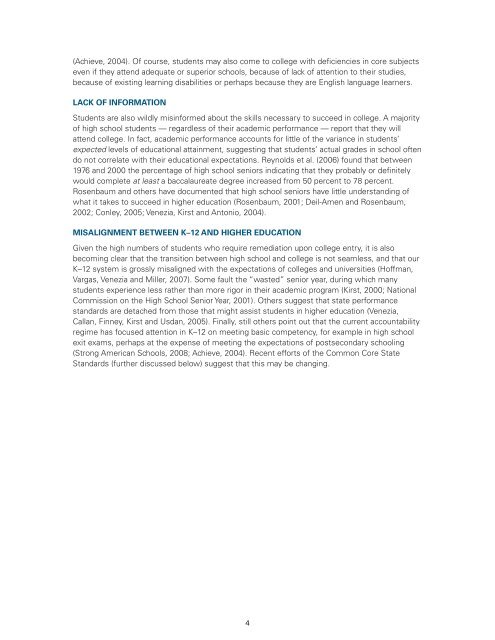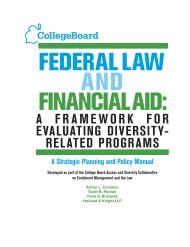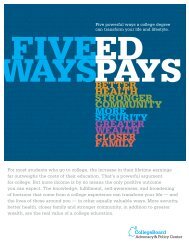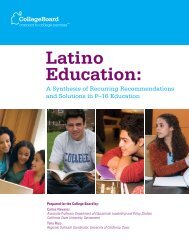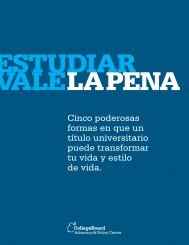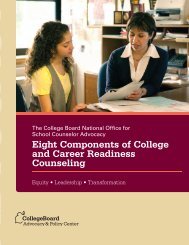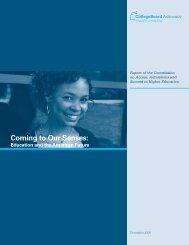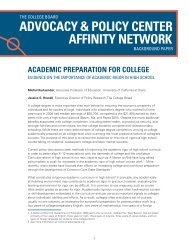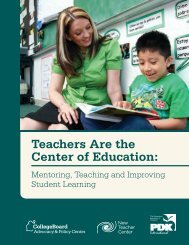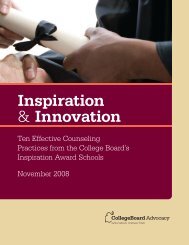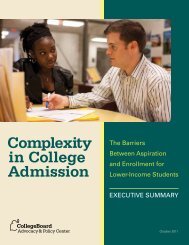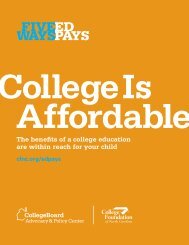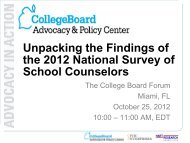Collegiate Remediation: A Review of the Causes and Consequences
Collegiate Remediation: A Review of the Causes and Consequences
Collegiate Remediation: A Review of the Causes and Consequences
You also want an ePaper? Increase the reach of your titles
YUMPU automatically turns print PDFs into web optimized ePapers that Google loves.
(Achieve, 2004). Of course, students may also come to college with deficiencies in core subjects<br />
even if <strong>the</strong>y attend adequate or superior schools, because <strong>of</strong> lack <strong>of</strong> attention to <strong>the</strong>ir studies,<br />
because <strong>of</strong> existing learning disabilities or perhaps because <strong>the</strong>y are English language learners.<br />
Lack <strong>of</strong> Information<br />
Students are also wildly misinformed about <strong>the</strong> skills necessary to succeed in college. A majority<br />
<strong>of</strong> high school students — regardless <strong>of</strong> <strong>the</strong>ir academic performance — report that <strong>the</strong>y will<br />
attend college. In fact, academic performance accounts for little <strong>of</strong> <strong>the</strong> variance in students’<br />
expected levels <strong>of</strong> educational attainment, suggesting that students’ actual grades in school <strong>of</strong>ten<br />
do not correlate with <strong>the</strong>ir educational expectations. Reynolds et al. (2006) found that between<br />
1976 <strong>and</strong> 2000 <strong>the</strong> percentage <strong>of</strong> high school seniors indicating that <strong>the</strong>y probably or definitely<br />
would complete at least a baccalaureate degree increased from 50 percent to 78 percent.<br />
Rosenbaum <strong>and</strong> o<strong>the</strong>rs have documented that high school seniors have little underst<strong>and</strong>ing <strong>of</strong><br />
what it takes to succeed in higher education (Rosenbaum, 2001; Deil-Amen <strong>and</strong> Rosenbaum,<br />
2002; Conley, 2005; Venezia, Kirst <strong>and</strong> Antonio, 2004).<br />
Misalignment between K–12 <strong>and</strong> Higher Education<br />
Given <strong>the</strong> high numbers <strong>of</strong> students who require remediation upon college entry, it is also<br />
becoming clear that <strong>the</strong> transition between high school <strong>and</strong> college is not seamless, <strong>and</strong> that our<br />
K–12 system is grossly misaligned with <strong>the</strong> expectations <strong>of</strong> colleges <strong>and</strong> universities (H<strong>of</strong>fman,<br />
Vargas, Venezia <strong>and</strong> Miller, 2007). Some fault <strong>the</strong> “wasted” senior year, during which many<br />
students experience less ra<strong>the</strong>r than more rigor in <strong>the</strong>ir academic program (Kirst, 2000; National<br />
Commission on <strong>the</strong> High School Senior Year, 2001). O<strong>the</strong>rs suggest that state performance<br />
st<strong>and</strong>ards are detached from those that might assist students in higher education (Venezia,<br />
Callan, Finney, Kirst <strong>and</strong> Usdan, 2005). Finally, still o<strong>the</strong>rs point out that <strong>the</strong> current accountability<br />
regime has focused attention in K–12 on meeting basic competency, for example in high school<br />
exit exams, perhaps at <strong>the</strong> expense <strong>of</strong> meeting <strong>the</strong> expectations <strong>of</strong> postsecondary schooling<br />
(Strong American Schools, 2008; Achieve, 2004). Recent efforts <strong>of</strong> <strong>the</strong> Common Core State<br />
St<strong>and</strong>ards (fur<strong>the</strong>r discussed below) suggest that this may be changing.<br />
4


